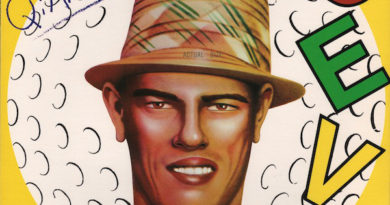Lots of Dreams That Aren’t There
Belle and Sebastian’s The Boy With the Arab Strap at 20

Belle and Sebastian aren’t the posters boys (and gals) of indie-rock shyness for nothing. Their monochromatic, high-contrast album art featured strangers posed like movie stills, and there’s no Belle or Sebastian in the group.
And on their third album, The Boy With the Arab Strap especially, that’s at times indicative of a hyper-referential worldview that might as well have functioned as a proto-Vampire Weekend ten years ahead of time.
There’s the album title, a reference to their fellow scots in the far more obscure Arab Strap, who weren’t fond of how assimilating the tribute was. And there are the two tunes sung by guitarist Stevie Jackson, about two very different music industry players: “Seymour Stein,” in which the man who signed Madonna and the Ramones is a character in the story, and an unnamed female interviewer from Gail O’Hara and Pam Berry’s influential indie-rock zine Chickfactor.
These disparate points on the musical map function as distancing devices from “who” the Belle and Sebastian’s four-headed narrator is comprised of (chief songwriter Stuart Murdoch cedes the lead vocal to Jackson as well as then-bandmates Isobel Campbell and Stuart David here for the first time), even as they graft their own meta-fanfic onto the narratives (both of the aforementioned Jackson songs are far more preoccupied with an unrequited crush than the named celebrity guest star). And Murdoch’s opening “It Could Have Been a Brilliant Career” is a more direct commentary about public-figure status than either: “She wears the clothes of an emperor / But her paintings are a sham.”
What’s interesting is how this sort of emotional sidestepping, an observational diversion from what would be the personalities we’re getting to know in song, is considered shy from a Scottish septet collective. But then again, it would be called plain old inscrutability with that American slacker hero, Beck, whom at the time of Arab Strap was finding his own feelings on the broken-hearted laments of Mutations, such as the self-explanatory “Nobody’s Fault But My Own.” Belle and Sebastian were more demure culture synthesizers than Mr. Hansen, though, and where he rough-cutted and barely-pasted jagged samples into his bogusflow, no seams showed with these Scots. David’s “A Space Boy Dream” was as out of place as this group ever got– a spoken-word Bitches Brew pastiche with a crazy conga breakdown; and even that turned neatly into the Wilson Pickett propulsion of “Dirty Dream Number Two,” one of the best songs this band’s ever done, like nothing unusual happened.
Note those signifiers though, because this supposed flagship of twee groups wasn’t just hyper-referential lyrically. They shared with Beck a complete mastery of their encyclopedic musical spectrum, whether on the dreamy, Jimmy Webb-influenced country shuffle “A Summer Wasting” or the “Eight Miles High”-style intro riff of “Simple Things” over a Charlie Watts pound, or the unexpectedly squelchy synth that slowly creeps into the epic “Sleep the Clock Around,” otherwise an easygoing folk-pop melody.

Belle and Sebastian wanted to tell stories but not necessarily theirs, over music borrowed, misremembered and filtered through one hue so that its trick timelessness could distort your nostalgic senses. More than any of the aesthetics, though, that timelessness comes through in their already-assembled melodic expertise. Campbell’s lovely “Is It Wicked Not to Care?” is a vibrant lullaby and “The Boy With the Arab Strap” (which Murdoch didn’t know was an erection-maintaining device at the time) a clap-happy singalong so indelible that its third verse is transmitted entirely via flute.
At the time, this album was shamed by a fledgling Pitchfork for xeroxing 1996’s renowned breakthrough If You’re Feeling Sinister, both an absurd charge (Strap debuted three more singers, electronics, genre pastiches) and a fascinating one: If your band establish from the start they can do almost anything, then how can they not repeat themselves?
Along with Beck, Belle and Sebastian brought the art of pastiche to exciting new places in the late ‘90s, as they’d go on to develop their Motown side (and flair for disco strings) with Trevor Horn in the mid-2000s with such further beloved works as Dear Catastrophe Waitress; the guitar breaks on “Stay Loose” and “Your Cover’s Blown” showed just how funk and rock they could get.
They were the prototype for many things that didn’t exist yet in indie, much less take over it entirely, like meta-narratives, large democratic collectives and ornate arrangements that would go on to replace Pavement’s patched-up guitars. But as later, lesser efforts proved, their unmistakable sound wasn’t the same without the songs. “Seymour Stein” alone birthed Jens Lekman’s drawn-out vibrato and Dr. Dog’s anthemic “Shadow People.” The circular, gorgeous clockwork of “The Roller Coaster Ride,” “Sleep the Clock Around,” and “Is It Wicked Not to Care?” rival anything on If You’re Feeling Sinister itself, or any of 1998’s proudest songwriting. For a supposed shy band, they didn’t hesitate to instantaneously share a sound with the world so distinct that they could be accused of repeating themselves so soon after arriving. Two decades on, it’s still a peak of a rather brilliant career.




